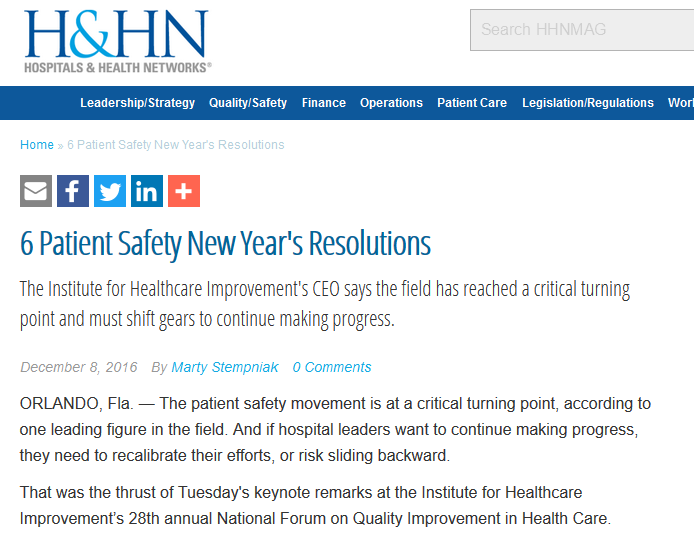
“At the Patient Safety Movement, we believe that ZERO preventable deaths by 2020 is not just a worthy goal. With the right people, ideas, and technology, it’s an attainable goal. Many of the pieces of this puzzle already exist. Solving this problem is a matter of connecting the dots of patient safety … The Patient Safety Movement is working to connect these dots in a number of ways: by collaborating and breaking down information silos that exist between hospitals, medical technology companies, the government, and other stakeholders; by promoting the sharing of data that can identify at-risk patients before they’re in danger; and by providing specific, actionable solutions that healthcare professionals can implement today so we can reach our goal together.” (http://patientsafetymovement.org/)”
“Earlier this month I [Tejal K. Gandhi, MD, MPH, CPPS, President of the National Patient Safety Foundation] had the privilege of attending the Patient Safety Global Action Summit in London. Co-hosted by the health ministers of England and Germany, the meeting brought together health officials of many countries, including England, Scotland, Switzerland, Germany, Saudi Arabia, and Japan, to name a few, as well as leaders of health care organizations and non-governmental organizations such as the World Health Organization, the National Patient Safety Foundation, and others … a goal of the meeting was to begin a ‘global drive to reduce errors, improve care, and save lives.’ It was truly inspiring to see international interest and real commitment from so many countries.” (http://www.npsf.org/blogpost/1198150/242507/Going-Global-on-Patient-Safety )
“[T]he thrust of Tuesday’s [December 6, 2016] keynote remarks at the Institute for Healthcare Improvement’s 28th annual National Forum on Quality Improvement in Health Care … Derek Feeley, IHI president and CEO, says that’s why it’s important to develop a system of safety so that we’re not playing whack-a-mole and bopping each new ugly problem when it pops up … he offered attendees a list of six items to tackle in 2017 to begin making this patient safety paradigm shift:
- Learn from what goes right, as well as what goes wrong.
- Move from reactive and responsive to proactive and generative.
- Invest in safety systems for learning, rather than just individual safety projects.
- Shift away from fear, blame and liability toward humility, trust and transparency.
- Stop feeling as though you have to keep individuals you serve safe and, instead, begin to co-produce safety with patients and their families.
- Understand that safety is more than just the avoidance of physical harm, but also the pursuit of dignity and equity.”
(http://www.hhnmag.com/articles/7903-patient-safety-news-years-resolutions?)
As the foregoing quotations demonstrate, patient safety movement leaders, in the USA and globally, continue to advocate for medical mistake mitigation and consequent reduction in patient adverse events. However, in my view the outlook for yet another calendar year is one of laudable goals and increasing awareness and healthcare provider participation improvement in results; but only marginal advancement and improvement, owing to the continuing application of methods and tools that address principally human factors and/or that exacerbate the problem. The root cause of virtually all medical mistakes is cognitive overload. Since this overload occurs because of the confluence of two virtually immutable factors, human cognition limitations and healthcare provider domain complexity; then the only feasible mitigating measure is cognitive support as only state-of-the-art and appropriately architected information technology (IT) can provide.
I propose that the required IT implementation is The Cloud Healthcare Appliance Real-Time Solution as a Service (CHARTSaaS) and its IT reference architecture, as described in the following presentations:
Please contact me, Pete Melrose, at 001-612-201-2301 or jpetermelrose@gmail.com, to discuss and decide re the implementation of a CHARTSaaS RA-compliant solution by your healthcare provider organization to relieve cognitive overload, which is arguably the root cause of medical mistakes, currently the third leading cause of patient deaths (re http://www.bmj.com/content/353/bmj.i2139).